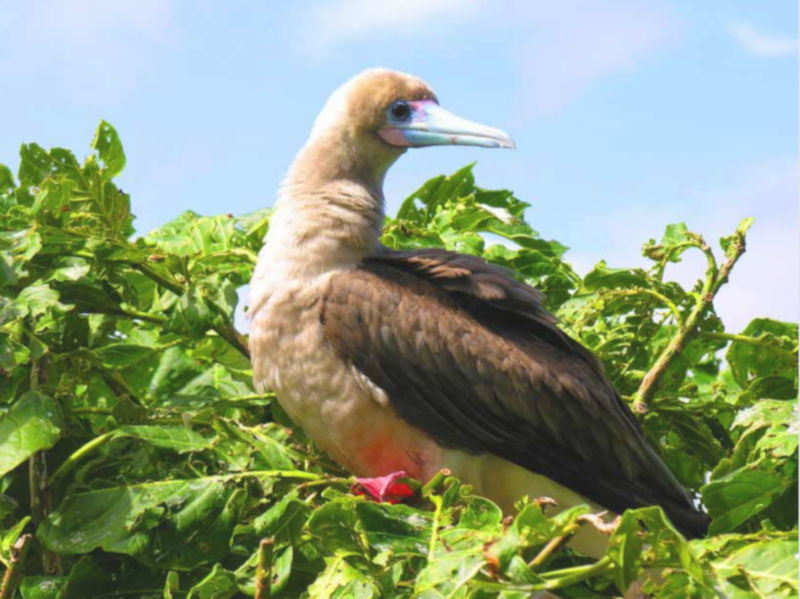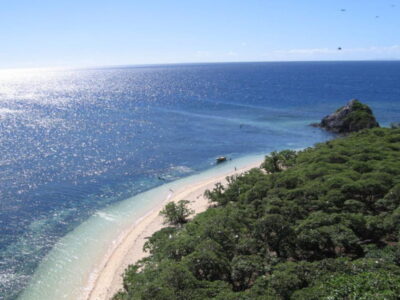Vatu Island, more commonly known as Vatu-i-Ra Island, is a small uninhabited island with an area of 0.023km 2 (2.3 ha), located in the Vatu-i-Ra channel between Vanua Levu and Viti Levu, about 15 km from the coast of Ra.
It is also known as “Bird Island” because of the large breeding colonies of seabirds on the island. Vatu-i-Ra Island is listed as a “Site of National Significance” in the NBSAP, and is one of the 28 internationally important bird areas recognized by BirdLife International for Fiji.
Vatu-i-Ra Island is approximately 300 m long and 100 m wide, with the higher northeast side and each end of the island composed of volcanic rock. The rest of the island is flat, and composed of coral sand.
Vegetation
Historically, the vegetation was dominated by the tree Pisonia grandis which had a canopy of 5 to 10 m on the flat land but less than 2 m on the hill side of the island. There are also other littoral trees and bushes.
Reptiles
The island is also used by nesting hawksbill turtles (Eretmochelys imbricata) and the Fiji endemic pygmy snake-eyed skink (Cryptoblecephalus eximius).
Birds
BirdLife International conducted habitat and species assessments on the island in 2003 and 2004, and the results confirmed the island was an Important Bird and Biodiversity Area (IBA), due to the large number of seabird species that inhabit the island.
Vatu-i-Ra Island supports nine species of breeding seabirds, which are all listed as ‘least concern’ on the IUCN Red List.
Of the nine species recorded, black noddies (Anous tenuirostris) had the largest population on the island with more than 20,000 pairs present, making it globally important for this congregating breeding species and therefore registered as an IBA.

Resident seabird species and their estimated population numbers, and status on the IUCN Red List.
Numbers are derived from the maximum count over a 10 year period (2005–2015) by BirdLife International.
The exception is white-tailed tropicbird which was last observed breeding on Vatu-i-Ra Island in 1975.
In recent years, tropicbirds have been observed foraging within the vicinity of the island but not recorded as breeding. Source: World Bird Database
Common names Scientific names Fijian Name Numbers
- Black noddy Anous tenuirostris Gogo
- Red-footed booby Sula sula Toro (yava damu) 600 Individuals
- Lesser frigatebird Fregata ariel Manumanunicagi 500 Individuals
- Brown noddy Anous stolidus Gogo 80 Individuals
- Black-naped tern Sterna sumatrana Ereqia 115 Individuals
- Bridled tern Onychoprion anaethetus Yaraqia 500 Individuals
- Brown Booby Sula leucogaster Toro 150 Individuals
- Greater crested tern Thalasseus bergii Ico, Idre 250 Breeding pairs
- White-tailed tropicbird Phaethon lepturus Lawedua 1 Breeding pairs
Rat Eradication 2006
The 2004 survey documented the presence of the Pacific rat (Rattus exulans) in high densities.
BirdLife International implemented an operation in 2006 to eradicate Pacific rats from the island, which can have a major impact on small ground nesting seabird species.
The European or black rat (Rattus rattus) and Norway rat (Rattus norvegicus) have not been recorded on the island but are widely distributed on the main island of Viti Levu.
After two years of conducting intensive post-eradication monitoring, the island was successfully declared rodent free in 2008 and has remained rat-free since.
In 2011, BirdLife International established an acoustic attraction and artificial nesting boxes on the island and has been maintaining the system since.
This was done to specifically attract and recruit threatened seabirds that are known to fly across the Vatu-i-Ra passage.
Land birds such as barn owls (Tyto alba), peregrine falcons (Falco peregrinus) and the invasive mynahs (Acridotheres tristis) have been observed on the island but are not considered residents.

